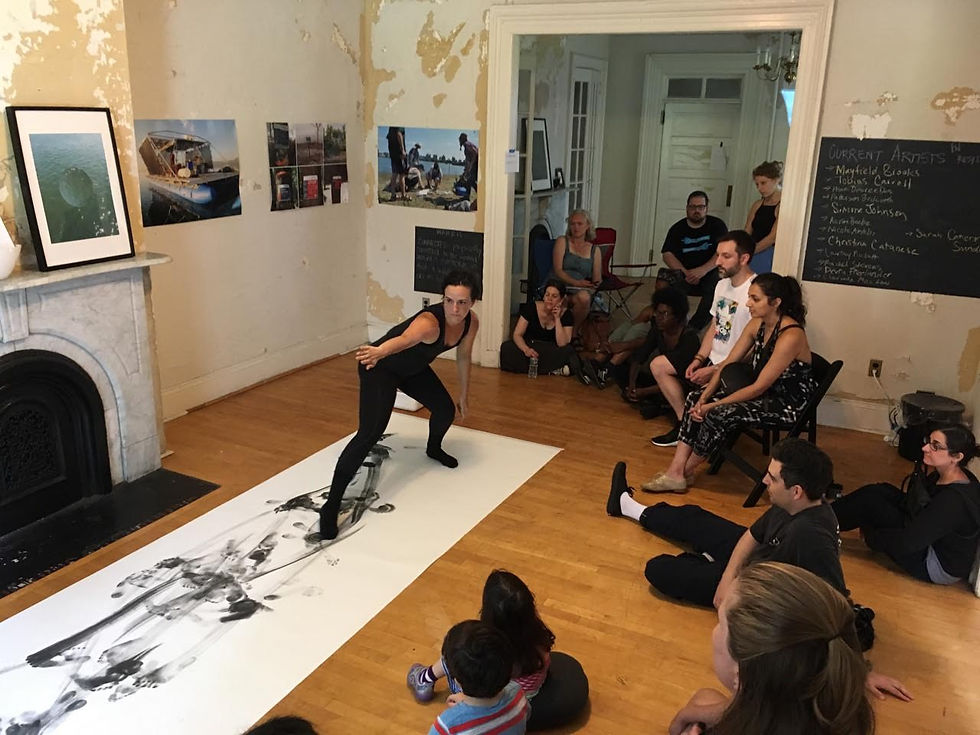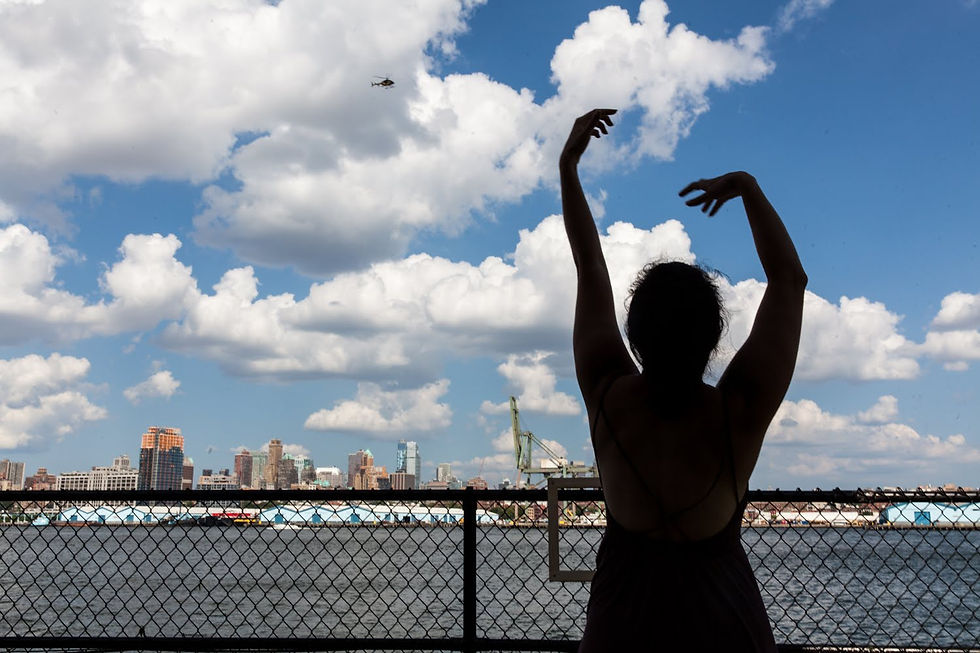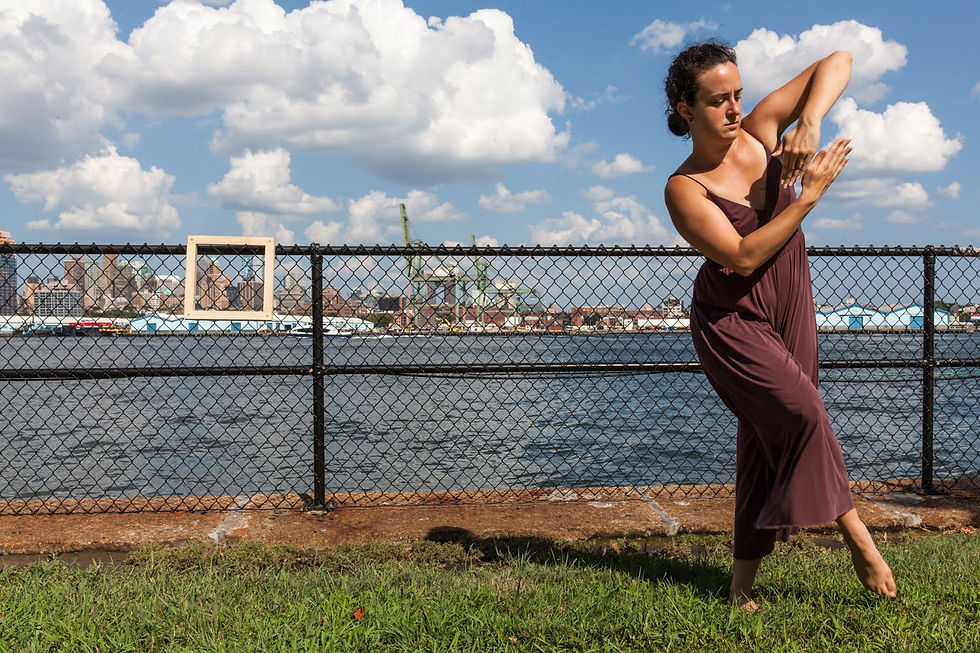TRACES: New York Waterways
Variety of works developed in 2018 at the Works on Water Residency, an incubator space on Governors Island in New York City for diverse investigations of water in the urban environment.
During this week-long artist residency, Catanese developed choreography and visual art works around modern dance and river system morphology. She also developed new methodologies for site-responsive dancemaking with roots in scientific methods. Catanese offered a public performance at the conclusion of her residency.
Video: modern dance and dance drawing creation
Duration: 4 minutes
Music: Zoe Keating, "Legions (War)" excerpt
Drawing: 4 feet x 12 feet,
Graphite on paper
More writing and images of this project art available in Underwater New York's Issue 16: Governors Island UnEarthed.
The Path of the Water
Written as a distillation of reading and research on New York City's water histories and futures
Some text borrowed from conversations, texts, and installations
The path of the water is wide, meandering, and deep in the upper East River, and narrow and straight in the lower part, due to glacial activity.
The path of the water is broader right below Roosevelt Island because of a change of harder rock to softer.
The path of the water turns east before the Manhattan bridges, for geologically unknown reasons.
The path of the water has grown narrower over time due to building and filling, increasing the speed and deepening the channel.
The path of the water is a drowned river valley.
The path of the water is often unseen.
The path of the water mixes saltwater and fresh.
The path of the water carries me.
The path of the water is a passage to the place where I have studio space.
The path of the water continues underneath the concrete, asphalt, and fill.
The path of the water tricks us into thinking that we live on solid ground.
The path of the water infuses the city with the smell of the sea.
The path of the water is something we turned away from, but are returning to.
The path of the water was carved by glaciers slowly, then quickly by a burst ice dam at Lake Ontario, which changed the whole world’s climate.
The path of the water can change the whole world’s climate.
The path of the water is not separate from the city.
The path of the water is subject to marine influences (tides, waves, salt) and riverine influences (freshwater and sediment).
The path of the water is liminal space - at the edges of the water, transgression flourishes.
The path of the water is an estuary. The Latin word origin also means tides, fire, heat, surge of the sea, passion, hesitation.
The path of the water is a reciprocal reshaping.
The path of the water flows both ways.
The path of the water is full of life forms blooming from the waste.
The path of the water is erratic.
The path of the water flows through and above the glacier valley.
The path of the water was transformed by the largest human-made explosion before the atomic bomb.
The path of the water is briney.
The path of the water devours.
The path of the water is a place of retreat and return.
The path of the water is a place of fortification and softening.
The path of the water has blurred edges.
The path of the water is inside the subway.
The path of the water is inside me.
The path of the water is a border that divides.
The path of the water is a convergence that unites.

8/12/18

8/12/18

Performance documentation

2018 Graphite on paper 4' x 12' Features the traces of one dancing body performing choreography in response to the waterways of New York - their histories, pathways, and how we think about their futures. Created in a live performance on Governors Island on August 12, 2018.

2018 Graphite on paper 4' x 12' Features the traces of one dancing body performing choreography in response to the waterways of New York - their histories, pathways, and how we think about their futures. Created in a live performance on Governors Island on August 12, 2018.

2018 Graphite on paper 4' x 12' Features the traces of one dancing body performing choreography in response to the waterways of New York - their histories, pathways, and how we think about their futures. Created in a live performance on Governors Island on August 12, 2018.

2018 Graphite on paper 4' x 12' Features the traces of one dancing body performing choreography in response to the waterways of New York - their histories, pathways, and how we think about their futures. Created in a live performance on Governors Island on August 12, 2018.

2018 Graphite on paper 4' x 12' Features the traces of one dancing body performing choreography in response to the waterways of New York - their histories, pathways, and how we think about their futures. Created in a live performance on Governors Island on August 12, 2018.

2018 Graphite on paper 4' x 12' Presented in "Water Art is the New Land Art," a small, documentary exhibition featuring new works created by fifty-four 2018 Artists-in-Residence with Works on Water.

2018 Graphite on paper 4' x 12' Presented in "Water Art is the New Land Art," a small, documentary exhibition featuring new works created by fifty-four 2018 Artists-in-Residence with Works on Water.

Graphite on tracing paper, 14" x 17" I selected parts of the large dance drawing to trace with drawn lines. This practice responds to the limitations of lines on a map to represent a landscape - while lines suggest a clean division between land and water, the reality is much more soggy and blurry. Similarly, tracing the marks made during a dance performance is a radically simplified version of the reality. Even so, the tracings resemble maps of their own, of unknown, invented landscapes.

Graphite on tracing paper, 14" x 17" I selected parts of the large dance drawing to trace with drawn lines. This practice responds to the limitations of lines on a map to represent a landscape - while lines suggest a clean division between land and water, the reality is much more soggy and blurry. Similarly, tracing the marks made during a dance performance is a radically simplified version of the reality. Even so, the tracings resemble maps of their own, of unknown, invented landscapes.

Graphite on tracing paper, 14" x 17" I selected parts of the large dance drawing to trace with drawn lines. This practice responds to the limitations of lines on a map to represent a landscape - while lines suggest a clean division between land and water, the reality is much more soggy and blurry. Similarly, tracing the marks made during a dance performance is a radically simplified version of the reality. Even so, the tracings resemble maps of their own, of unknown, invented landscapes.

Graphite on tracing paper, 14" x 17" I selected parts of the large dance drawing to trace with drawn lines. This practice responds to the limitations of lines on a map to represent a landscape - while lines suggest a clean division between land and water, the reality is much more soggy and blurry. Similarly, tracing the marks made during a dance performance is a radically simplified version of the reality. Even so, the tracings resemble maps of their own, of unknown, invented landscapes.

Graphite on tracing paper, 14" x 17" I selected parts of the large dance drawing to trace with drawn lines. This practice responds to the limitations of lines on a map to represent a landscape - while lines suggest a clean division between land and water, the reality is much more soggy and blurry. Similarly, tracing the marks made during a dance performance is a radically simplified version of the reality. Even so, the tracings resemble maps of their own, of unknown, invented landscapes.

Photo by Robin Michaels

Photo by Robin Michaels

Photo by Robin Michaels